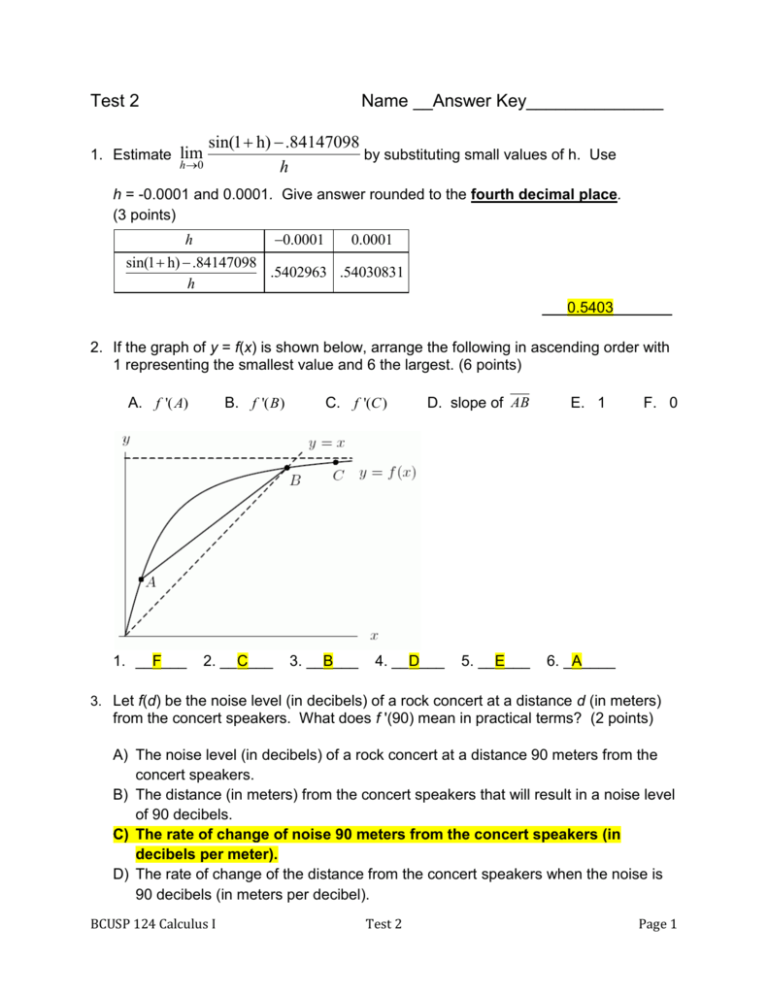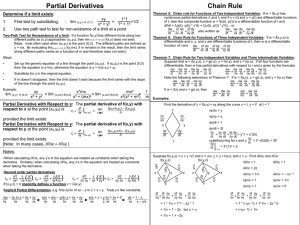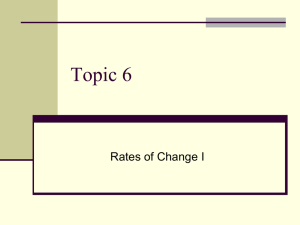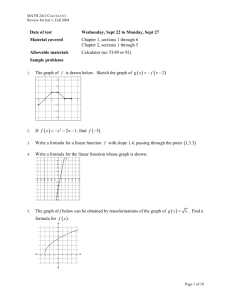First
advertisement

Test 2 Name __Answer Key______________ sin(1 h) .84147098 by substituting small values of h. Use h 0 h 1. Estimate lim h = -0.0001 and 0.0001. Give answer rounded to the fourth decimal place. (3 points) 0.0001 h 0.0001 sin(1 h) .84147098 .5402963 .54030831 h ___0.5403_______ 2. If the graph of y = f(x) is shown below, arrange the following in ascending order with 1 representing the smallest value and 6 the largest. (6 points) A. f '( A) 1. __F___ B. f '( B ) 2. __C___ C. f '(C ) 3. __B___ D. slope of AB 4. __D___ 5. __E___ E. 1 F. 0 6. _A____ 3. Let f(d) be the noise level (in decibels) of a rock concert at a distance d (in meters) from the concert speakers. What does f '(90) mean in practical terms? (2 points) A) The noise level (in decibels) of a rock concert at a distance 90 meters from the concert speakers. B) The distance (in meters) from the concert speakers that will result in a noise level of 90 decibels. C) The rate of change of noise 90 meters from the concert speakers (in decibels per meter). D) The rate of change of the distance from the concert speakers when the noise is 90 decibels (in meters per decibel). BCUSP 124 Calculus I Test 2 Page 1 4. Find the derivative of g ( x ) 7 at x = 1 algebraically. (5 points) x 1 7 7 7 7 (1 h) 1 1 1 (2 h) 2 2(2 h) lim lim h 0 h 0 h h 2(2 h) lim 7 2 7(2 h) h 2(2 h) h 0 x3 , 5. The graph of f ( x) 2 x 1 a graph of f '( x) . (5 points) 7h 7 7 lim h0 h 2(2 h) h0 2(2 h) 4 lim for x 0 is shown below. On the same graph, draw for x 0 y 4 3 y = x2 + 1 2 f '(x) 1 -2 -1 o x 1 2 -1 -2 y= x3 -3 BCUSP 124 Calculus I Test 2 Page 2 6. Find the derivative of f ( x) x 1 using the definition of the derivative. (8 points) x ( x h) 1 x 1 f ( x h) f ( x ) x h x lim lim h 0 h 0 h h x h 1 x 1 x h x x( x h) lim x( x h 1) ( x 1)( x h) lim h 0 h x ( x h ) h 0 hx( x h) x 2 xh x x 2 xh x h h lim lim h 0 h 0 hx ( x h) hx( x h) 1 1 lim 2 h 0 x ( x h ) x Or simplify f ( x) f ( x) 1 x 1 x 1 1 1 and find the derivative using the definition on x x x x 1 . x 7. Sketch a graph of a continuous function f(x) with the following properties: (5 points) f ''( x ) 0 for x 1 f ''( x ) 0 for x 1 f '(1) is undefined f '(1/ 2) 0 f (0) 0 y x 1 BCUSP 124 Calculus I Test 2 Page 3 8. One of the following graphs is of f ( x ) , and the other is of f '( x) . Is f ( x ) the first graph or the second graph? (2 points) ____ First ________ 9. The graph of y = g(x) is given in Fig. 7. (6 points) (a) At what integer(s) is the slope of the tangent line negative? (b) At what integer(s) is the slope of the tangent line positive? __-2, 3__________ ___0____________ 10. At which points is the function in Fig. 15 discontinuous and at which points is it not differentiable? (6 points) Discontinuous at x = ___0, 2________ BCUSP 124 Calculus I Test 2 Not differentiable at x = _ 0, 2, 3, 4____ Page 4 11. The revenue, in thousands of dollars, earned by a gas station when the price is $p per gallon is R(p). (5 points) a. What are the units of R’(3)? Interpret this quantity. The units are thousands of dollars (revenue) per dollar per gallon (price). It is the rate of change of the revenue when the gas price is $3. b. What are the units of (R-1)’(5)? Interpret this quantity. The units are dollar per gallon (price) per thousand dollars (revenue). (R-1)’(5) gives the rate of change of the price per gallon when the revenue is $5000. 12. (a) Between which pair of consecutive points in Figure below is the average rate of change of k (6 points) Smallest? __ D and E _______ Closest to zero? ___ B and C______ (b) Between which two pairs of consecutive points are the average rate of change of k closest? ___ A,B and C,D_______ 13. Circle True or False. (2 points each) a) Assume that f is a differentiable function defined on all of the real line. Is it possible that f(x) > 0 everywhere, f ‘(x) < 0 everywhere, and f”(x) > 0 everywhere? (True or False) b) If f(a) ≠ g(a), then f’(a) ≠ g’(a). ( True or False) c) If a function is not continuous, then it is not differentiable. (True or False) d) The function f(x) = x2 is monotonic on any interval. (True or False) BCUSP 124 Calculus I Test 2 Page 5







